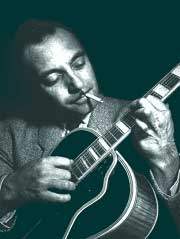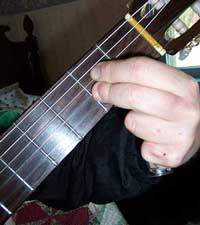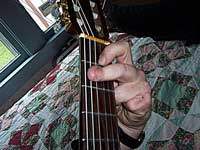A guitarists hand Injury. When is less really more?
They're out there performing miracles. Musicians with what are called "handicaps." My friend and occasional composing partner David Hoffman has played for Ray Charles for 13 years and everyone knows about this icon. Most of us have heard about the genius of guitarist Django Reinhart's abilities with a very damaged fretting hand. Few others may know a bit less of Jerry Garcia's missing digit. But right now I'm going to focus on what I know and how I apply my style of playing on my six albums (not all my albums are fingerstyle guitar though).
The saying "less is more" is actually a widely used term in music as well as other art forms. Musically, it's easy to try to overplay in order to impress, rather than to make the most appropriate statement relative to the work at hand. I'm still working on that.
I have been building stringed instruments for about 25 years, as well as playing guitar, and other more exotic instruments in my recordings. Early in my career, I lost a few fingers in an accident. A life changing event is a funny thing. For me it was instantaneous. I knew in a "nanosecond" that my life was changed forever. BAM!
Some go into denial, but there was too much traumatic evidence for me to do this. However, my event is minor when compared to most. A guy I know was hit by an RPG in Viet Nam. He was a miracle and was literally put back together. Another man I know was a prisoner of the Japanese and was one of the builders of the Bridge on the River Kwaii (My fathers generation). As a large Scotsman of 6'2" weighing 110 pounds and having suffered through diphtheria, Beri Beri, Jungle Ulcer, and the removal of a Kidney without anesthetic, he knew loss. Yet, he would say his loss was his gain. He had walked through the coals. He found himself through loss. It was his vehicle.
I was lucky compared to many who experience life changing events. My event would have to be considered tiny by comparison. Yet, at the time it was difficult for me. Loss, fear, and grief are all relative things.
But, in my loss, I too found direction. My musical path could not exactly follow the straight course. I could not reach certain "voicings". With only one good finger, I could not repeat 1/16th note "pull off's". Certain melodic directions I loved and heard others play, would have to be painted differently. Perhaps my direction could be initially inspired by another artist's influence, But, I did not have the ability to repeat what he or she did. I literally didn't have the physical capacity to do so. And of course, relative to certain musicians, I did not posses the talent of Django Reinhart whose fretting hand was severely burned in a fire.

There are others who have played wonderfully with injuries; Les Paul suffered a severe injury to his arm in an automobile accident. I should also mention the banjo player from the band Mountain Heart named Barry Abernathy. I saw him from a distance, but it looked to me like the only thing he was working with was a thumb and part of another finger. He was amazing! When my first album ("Various Waves") came out in 1989, a fella that was the producer for the largest syndicated instrumental radio show in America called to tell me he was placing the album in the top five of the year. Among flattering things he had to say was that he was glad I didn't use the particular type of phrasing popular at that time. Little did he know that I actually tried to play that style on the tune, but I couldn't cut it. I had to make up a linear passage that worked within the limitations of my damaged "paw."

As a child, I believed I had nothing. I was told by others I did, but I didn't believe them. I now know, that I have a voice. The trick is to know it, accept it, and try not to stray from being honest within yourself. And, of course, honesty is knowing your limitations without being limiting. This is a constant battle. As constant as the ego is prominent. But, the ego is another, far deeper story that would take much more typing.
My limitation has allowed me to approach sound design in a unique fashion. This fashion is shaped by the tools I have. In all aspects, my limitations have allowed me to paint pictures that are - well, MY pictures. This begs the question: When do you accept, and when do you push beyond? Perhaps this is similar to what Buddhists call The Middle Path; One that is taken a step at a time. A dash of instinct, a spoon of whim, a cup of inspiration and outer influences, an ounce of self acceptance, with two ounces of the insane notion that despite this self acceptance, you still need to get off your arse and go a step beyond. You need to go past that place you thought was the end of the trail.
Perhaps I am preparing a soup of contradiction, but as I now think about it, I guess that's exactly what life is. Look at the Bible, marriage, politics, art, philosophy, etc. Following ones "whim" is following one's heart. Getting to know one's heart is a deeper matter all together.
Some of us have limitations we do not recognize. Some of us recognize limitations that are not there. Each one has to evaluate where he or she is, based on the entirety of life's experiences. I will focus on my physical limitation (my mental limitation is another, and probably much larger web page). I have a good index finger and thumb (see photo above). The middle and ring finger have no bone in the ends (so the last knuckle cannot bend). The flesh was fashioned from a graft on my leg. During this 30 day period when my fingers were sewn on to the flesh of the thigh, I literally had to walk around with my hand in my pants for a month. Very embarrassing in public. This leaves so much wide open for humor that I will leave you with your own imaginations. My tendency is to be silly and sometimes self deprecating. The former is fun, the latter a burden we best cast to the wind.
Now, back to the specifics of my limitation. When the middle and ring finger "press" on the fingerboard of an instrument, they flatten out (No bone in the ends.). Consequently they are gonna hit more than one string at a time. The challenge is to avoid muting strings I don't intend to mute, and using one finger to press two strings at a time. This maybe something some folks playing an open A chord on a guitar they could do. See photo.


It is tempting to replicate another's statement. There are so many great musicians out there with so many great chops. But some chops, because of altered tunings (for example: open "D" tuning.), I use, and my injury are pretty tough to accomplish. So, you are forced to create your own melodic or chordal statement based on your limitations. From a linear fashion, this can lead to melodic statements that are "unique". As I said earlier, this was a good thing for me! You choose your direction based on what you can do, rather than copying what another has done. From a chordal standpoint, the alternate tunings help a bit with certain chord formations (Remember the example of using one of my fingers to press two strings).. But, without the extra "digits" adding a 6th, 7th, or 9th to a three note chord can be tough. Or, if you can do it in the first position on the neck, you cannot do it in the second neck position, etc.
This points out voicing limitations. Again, while it may be frustrating not to be able to make the same statement another is making, you are forced to make a statement based on your ability or limitation. So, you have a completely different choice criteria. You cannot replicate that famous 8 bar Stevie Ray Vaughan blues line, but you can start on it, and then follow your limitation until it elevates you to your own unique voice of expression. Remember, in music there can be many methods for choosing what to do next. Everyone remembers the famous George Martin story about him cutting the recording tape in pieces, scattering it on the ground, and then randomly taping it back together to create the wonderful musical collage on the "Sgt Pepper's" album in 1967.


The above two photos show how I utilize "basic" approaches using an "open" guitar tuning. This can be a simple way to play. Strum the guitar open and you have a D chord. Strum the 2nd fret you have E. Strum the 3rd fret, and you have an F chord etc. Of course there are many other chord voicings available in open tunings, but this gives you a simple idea. Take a peek at any Richie Havens performance to see how this simplistic approach can be utilized very creatively and soulfully. You may click "At Prairies Edge" to hear me play a tune in open D from my album "A View From The Plain".
There are many altered tunings, or open tuning schemes available as used by the great blues masters of the past, as well as folkies of the past and present. Right now, off the top of my head, I immediately think of early Joni Mitchell recordings, as well as a big influence of mine named John Fehey. Many many others utilize it as well, Steffan Grossman, Peter Lang, William Ackerman, Alex DeGrassi, Richie Havens,and Leo Kottke come to mind.
You can use these chord formations on the inside strings allowing the outside strings to "drone" or play in the background. There are limitations. As I said earlier, I record and play with my friend David Hoffman. He is a "bank" of music theory and even writes some of Ray's arrangements. Our approaches are extremely different - matter of fact it seems like a strange match. But, we get the job done. I recognize my limitations and don't venture past what I know I can do. Don't get me wrong though, I sometimes do push it. If I didn't, Dave would get bored. But, if I didn't recognize those limitations I would end up mixing oil and water. Effective for when you really want to make a dissonant musical statement, but not always appropriate.
With this new approach it becomes evident that the right hand (Or the finger picking hand if you are right handed.), takes over a large role with syncopation. For example, having the thumb play the bass lines, as the index, middle, and ring fingers pluck out the melody. The above musicians are good examples of this. But, some have taken this much further. Stanley Jordon comes to mind as well as probably the best guitarist I've ever seen in person - Martin Taylor. Martin is a Scotsman, and pure genius. He bought a guitar from another guitar builder here in town named Bill Barker. When off tour, he visited Bill and gave us a concert. He had so many things going on at once it made my head spin. Simply put, his fretting hand plays melody and the right hand plays bass. If any of you have seen a Chapman Stick player, you can immediately visualize this marvelous technique.
It sounds like I'm getting off subject, but this brings another aspect of the power of limitation. There are certain folks like Taylor, Jordan, Pat Metheny and others that are such geniuses that it would tempt one to just put the guitar away. Not many folks are going to be able to play with this level of skill. But, that is their level of skill, and their path. Each of us needs to find something valid to say in our way. It is as easy as placing your ego in a position of perspective. Not easy.
Years ago, I was sitting amongst artist friends and the subject of Eddie Van Halen came up (circa 1985). Everyone was astonished at his virtuosity. But we recognized something missing. The guy sitting next to me says, "That boy just needs to suffer some more." We all knew exactly what he was saying.
B.B. King can say in 5 notes what another may need 25 to say. We need to tame the ego and "be what we is". I call this Popeye Consciousness. "I yam what I yam, and that's all that I yam." Do the best you that you can do. And look farther than speed and virtuosity. Look three dimensionally at the world. What lies underneath? Why did painters at the turn of the 19th century become bored replicating reality? And today, why have many photographers become bored reproducing reality with a tool designed to do just that? What is heart? And what is the heart? Read, think, imagine, wonder, create.
Don't be afraid to travel your own path and "say it your way". Copying is natural. We learn from the greats that have come before us. But, to try to keep from being a clone of what is being painted around you is the "big dog difference". Not many people follow their own musical path and not many people think for themselves. Listen to the radio, or look at the cover of People Magazine, or the front page of AOL. I'm yawning already. Use the tools you have been given. Check your perspective and assure yourself you aren't standing on your own foot and holding you back. Figure out ways around obstacles (perhaps one of the major reasons we are here on this planet). Read and listen to the masters. Shelly, Keats, Beethoven, Copeland. And, investigate simplicity. Something simple can be valid, deep, and as strong as iron. Look at a Beatle's tune, The Fender guitar, a dulcimer, and play with the imagination of a child who has never known the crack of the whip telling them, "You can't do that!"
Paul Adams has six albums in a number of musical genres, stays busy building musical instruments, writing stories and poetry, researching ethnomusicology, and working in the mental health field (a much higher calling than the music business).